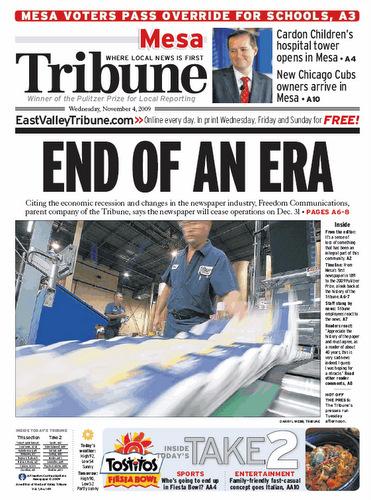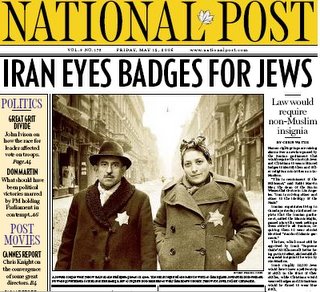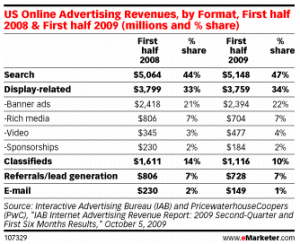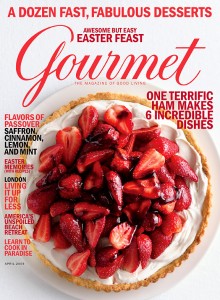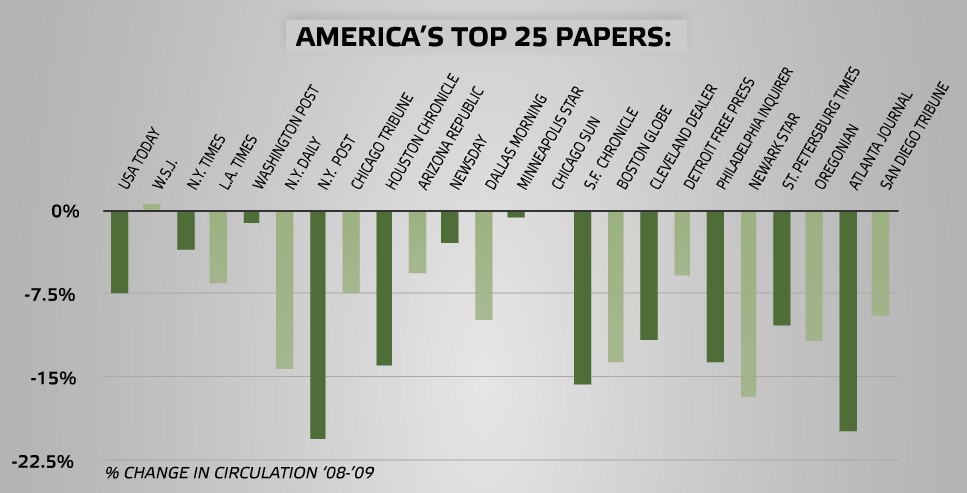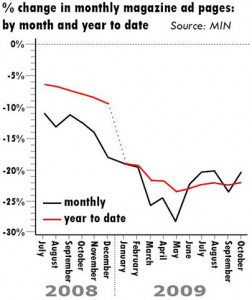There are more signs that the advertising environment is improving. IDC says global online ad spending just 1% to $14.6 billion. While that’s still down, it’s an improvement over the negative 5.6% growth registered in the second quarter and the smallest drop since the ad market started going south a year ago. IDC expects the US market to decline another 1% or so in the fourth quarter, but now foresees growth by the first or second quarter of 2010. IDC says search advertising will lead the industry out of its slump, but that the big winner is Microsoft’s Bing, not Google. However, Bing may not hold its gains once growth returns. Display advertising continues to be a downer. America Online, which derives most of its ad revenue from display units, saw its online ad revenue fall 23% in the quarter. AOL has lost nearly half its market share over the last four years.
Miscellany
The Awl takes a graphical look at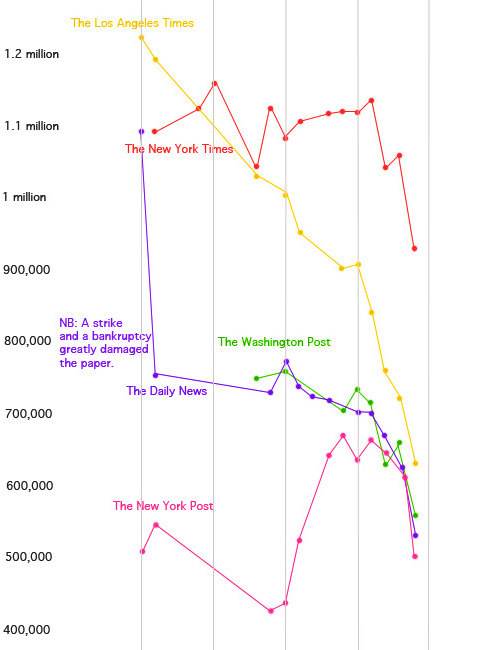 the circulations of major US newspapers over the last two decades. The data is predictably horrible, but the chart makes some trends clearer. One is that the precipitous circulation declines began almost at the same time – around 2006. Another is that the trends haven’t been consistent for everyone: The Wall Street Journal has more or less held its own while the New York Post’s circulation today is only slightly below 1991 levels. “The once-captivating battle of the New York City tabloids has become completely moot,” the author notes. In fact, the the only battle in New York now seems to be a race to the bottom.
the circulations of major US newspapers over the last two decades. The data is predictably horrible, but the chart makes some trends clearer. One is that the precipitous circulation declines began almost at the same time – around 2006. Another is that the trends haven’t been consistent for everyone: The Wall Street Journal has more or less held its own while the New York Post’s circulation today is only slightly below 1991 levels. “The once-captivating battle of the New York City tabloids has become completely moot,” the author notes. In fact, the the only battle in New York now seems to be a race to the bottom.
The biggest loser in the timeline is the Los Angeles Times, whose 50% drop in circulation over the last 20 years is the visual equivalent of a topographic map of the Grand Canyon. Whatever malaise is afflicting US dailies, the LA Times has got a triple dose of the illness.
Jeff Jarvis has a 25-minute video of an anti-protectionist speech he made to Munich Media Days a week ago, but what caught our eye was a comment by a reader that attempts to explain the changing economics of journalism. Bob Wyman notes that mass media economics of the past century made it a virtue for journalists to be objective because that was how you amassed the largest possible audience in markets defined by geography. Once the geographic limitations were lifted, the rules changed. Today, journalist maximize their value by being leaders in advocating certain points of view. Specialization and bias (supported by expertise) become a source of differentiation.
“This will result in greater quality of journalism on specialist interests being made available across the board as well as probably increased revenues to individual journalists who are successful at becoming leaders in particular market segments,” Wyman comments. This is worth pondering for journalists who mourn the loss objectivity in their profession. Bias may actually be a factor that makes them distinctive and marketable in the future.
The Wall Street Journal had the Detroit Media Partnership on the hot seat last week with a story about advertiser involvement in editorial decisions the Detroit Free Press, including story topic and placement. While not alleging direct advertiser interference, the Journal story, which was provocatively headlined “Major Detroit Newspaper Takes Cues From Advertisers,” pointed to a 10-page package on Medicare open enrollment that appeared on Nov. 1 that it said was inspired by an idea submitted by Humana and that carried extensive advertising from the health care provider. Retailer Target was also involved in conceiving and scheduling recent articles on secondary school education that were placed adjacent to Target ads. “The publisher has redrawn…traditional boundaries,” the Journal wrote. “Generally, papers make layout decisions within the newsroom, not in connection with ad placements.”
The Free Press was pretty steamed. Romenesko has the letter that Free Press Editor/Publisher Paul Anger sent to the Journal. The Freep didn’t consult with advertisers on any story content, although it did work with them on schedules, Anger said. “We did nothing to compromise the newsroom while creating a win-win-win for our news coverage, for readers, and for advertisers,” he wrote. Anger also tweaked the Journal for carrying a special section on mutual funds stuffed with ads from investment firms on the same day that the story about the Free Press appeared.
The Claremont (N.H.) Eagle Times, which died in July and rose from the ashes last month under a new owner, is in the news again. This time it’s over the state of New Hampshire’s unusual decision to guarantee part of a $250,000 loan to the paper’s new owner, Pennsylvania-based Eagle Printing & Publishing LLC. The New Hampshire Business Finance Authority, a state agency, agreed to guarantee 75% of the loan because of the potential for the Eagle Times to preserve and create new jobs in the area. The nearby Valley News devotes some 1,100 words to its analysis, focusing on the potential conflicts of interest created by a debtor covering the very same politicians who are providing its sustenance. However, no pols quoted in the piece seem to believe things will change that much over a lousy $187,500 in capital.
Quote from a short piece by Paul Bradshaw on Online Journalism Blog about monetizing content and audience: “I think there’s an enormous amount of vanity among journalists who forget that people buy and bought newspapers not just for journalism but crosswords, cartoons, TV listings and indeed advertising.”
